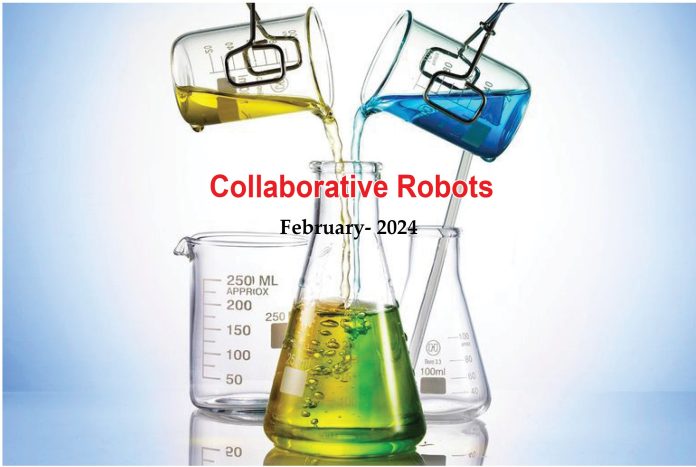The first reference to robots in the modern sense comes from the 1920 play R.U.R. (Rossum’s Universal Robots) by Czech writer Karel Čapek. The term “robot” itself was coined by Čapek’s brother, Josef Čapek, derived from the Czech word “robota” meaning “forced labour” or “serf”. Although the play doesn’t delve into the technical details of robot creation, it introduces the concept of mass-produced “artificial humans” working as labourers. These sparked discussions about the ethical and societal implications of robots, marking the birth of the modern concept that continues to fascinate and challenge us today.
Robotics is one of the nine pillars of Industry 4.0, also known as the fourth industrial revolution. It plays a crucial role in transforming traditional manufacturing and other industries into more automated, data-driven, and interconnected systems.
Collaborative Robots
The concept of cobots, or collaborative robots, was first introduced in 1996 by J. Edward Colgate and Michael Peshkin, professors at Northwestern University. They filed a patent for “an apparatus and method for direct physical interaction between a person and a general purpose manipulator controlled by a computer.” This initial idea aimed to create robots safe enough to work alongside humans. However, the wider adoption of cobots and their entry into the industrial space took some time. In 2008 Universal Robots released its first cobot, the UR5, which could safely operate alongside humans without needing safety cages. This is considered a significant step in bringing cobots to the forefront. In 2010, the first ISO standard for cobots was published, providing guidelines for safe operation with humans. In 2012, Rethink Robotics introduced the Baxter cobot, designed for a variety of manufacturing environments.
Cobots vs Robots
Cobots and robots share a robotic body, but their goals differ. Robots are solo performers: powerful, precise, but often isolated in cages due to their strength and speed. Cobots are collaborative companions: lighter, adaptable, and designed to work safely alongside humans. Robots work independently, often behind cages, excelling at repetitive, high-precision tasks like welding or assembly. Cobots share the workspace, assisting with tasks like material handling or quality checks, allowing for human-robot interaction and flexibility. Cobots are built with safety features like sensors and limited strength. This lets them work near humans without risk. Robots prioritise power and precision, requiring separation for safety. Robots often require complex programming by engineers. Cobots are designed for user-friendly programming, sometimes even allowing operators to hand-guide them, making them accessible to a wider range of users. Robots tend to be larger and more expensive due to their complex features. Cobots are generally smaller, lighter, and more affordable, making them accessible for smaller businesses. In essence, robots are the powerhouses, while cobots are the team players, bringing automation closer to humans and opening doors to new collaborative possibilities.
Applications
Precise and repetitive tasks like mixing chemicals or dispensing reagents are perfect for cobots. Equipped with sensitive grippers and cameras, they can accurately handle containers, weigh ingredients, and mix them according to recipes, eliminating human error and ensuring consistency. This is crucial for speciality chemicals, where small inaccuracies can have major consequences. Inspecting products for defects or contamination is a tedious and potentially risky job for humans. Cobots, equipped with vision systems and sensors, can perform these tasks with exceptional accuracy and at higher speeds. They can detect even minute imperfections, ensuring product quality and reducing the risk of human exposure to harmful chemicals. Lifting heavy containers and repetitive packaging tasks can lead to injuries and fatigue. Cobots are ideal for these physically demanding jobs. They can efficiently palletise boxes, label products, and handle heavy loads, alleviating human strain and improving productivity. This is particularly valuable in industries like fertiliser production, where large volumes of materials are handled.
Lab Automation
Cobots are game-changers for lab automation. These robotic partners free up skilled technicians from repetitive work like capping samples and labelling, allowing them to focus on higher-level tasks. Cobots, designed for safe collaboration with humans, tackle various tasks like sample handling and pipetting with accuracy, reducing errors and improving overall efficiency in diverse lab environments. Cobots tirelessly perform these routines with precision, boosting lab efficiency and consistency. The increased output and more consistent results translate into reduced cycle time for development and accelerate the discovery of new compounds.
Special Materials
With the rise of cobots, the need for specialised materials tailored to unique requirements has become crucial. Cobots are increasingly used to fit into tight spaces. As cobots with more degrees of freedom are more modular, their design can also become more complex – hence need to be produced with material innovations that provide greater freedom of design and ease of processing. Leading chemical giant BASF has emerged as a major player in this field, developing innovative materials that enhance cobot safety, performance, and functionality. High-performance polyamide offers excellent strength, stiffness, and dimensional stability while being 20% lighter than metals. This helps reduce cobot weight, leading to increased energy efficiency, faster movements, and improved safety. Lighter robots exert less impact in case of accidental contact with humans. Polyurethane has remarkable elasticity and shock absorption properties, making it ideal for cobot parts that may come into contact with humans. This material cushions impacts, minimises injury risk, and complies with safety standards. Polyethersulfone offers exceptional heat resistance, chemical resistance, and dimensional stability. Its moldability allows for complex, lightweight designs, enabling greater design freedom and customisation for cobot parts.
Way Forward
While the adoption of cobots is steadily increasing, it is still considered nascent compared to traditional industrial robots. The International Federation of Robotics predicts cobots to grow at an annual rate of 40%, suggesting they could account for 15% of the total robot market by 2028. While larger manufacturing companies adopt cobots more readily, the trend is shifting towards increased accessibility for small and medium-sized enterprises (SMEs) due to technological advancements, cost reductions, and easier user interfaces. Although affordability is improving, cobots still require a significant initial investment, deterring some businesses. Integrating cobots seamlessly into existing workflows and training employees to leverage them effectively takes time and resources. Ensuring safe human-robot collaboration requires proper risk assessments and safety measures.
Epilogue
Cobots are still evolving, and their potential in the chemical industry is vast. As they become more sophisticated and cost-effective, expect to see them playing an even larger role in the future, shaping a safer, more efficient, and productive chemical landscape.
































